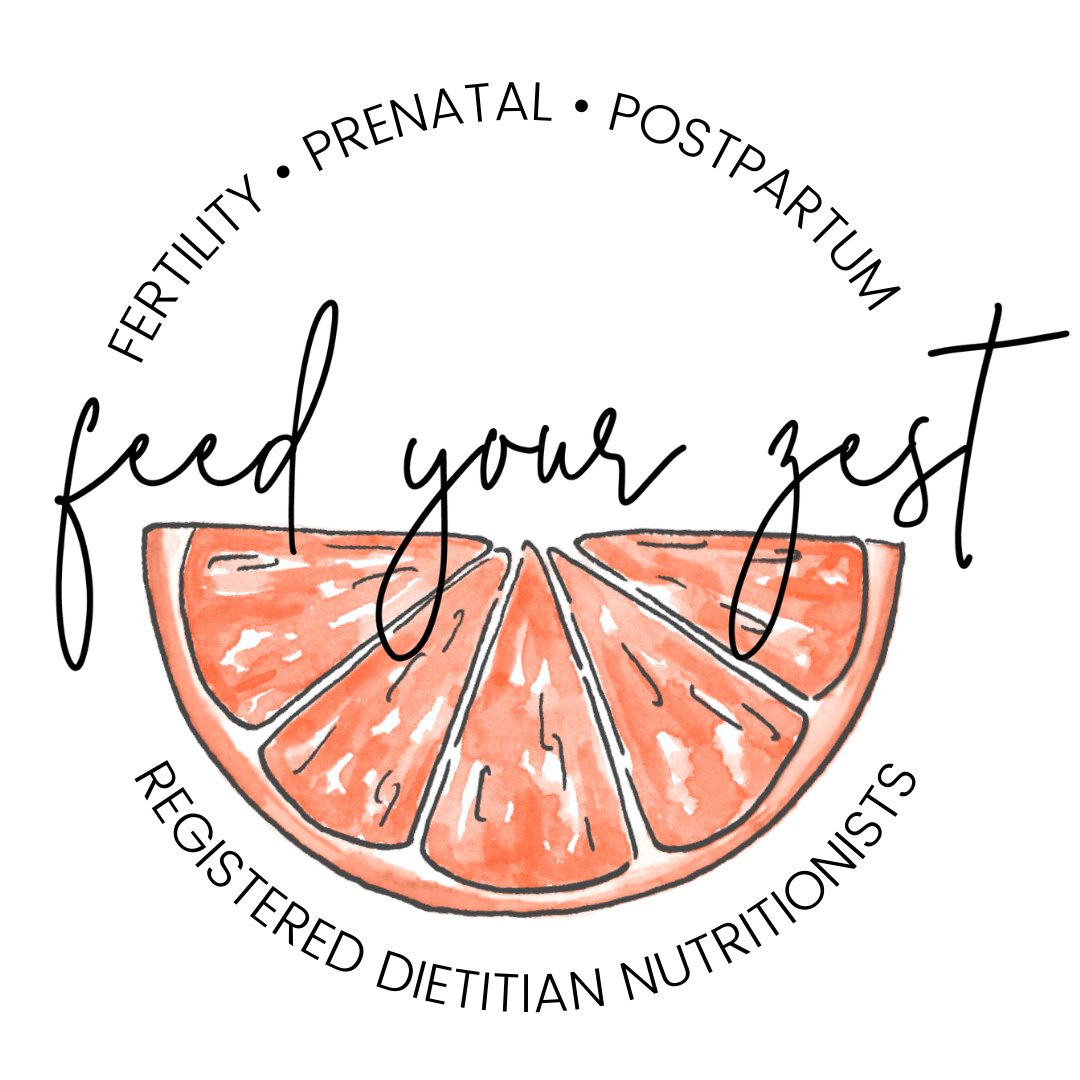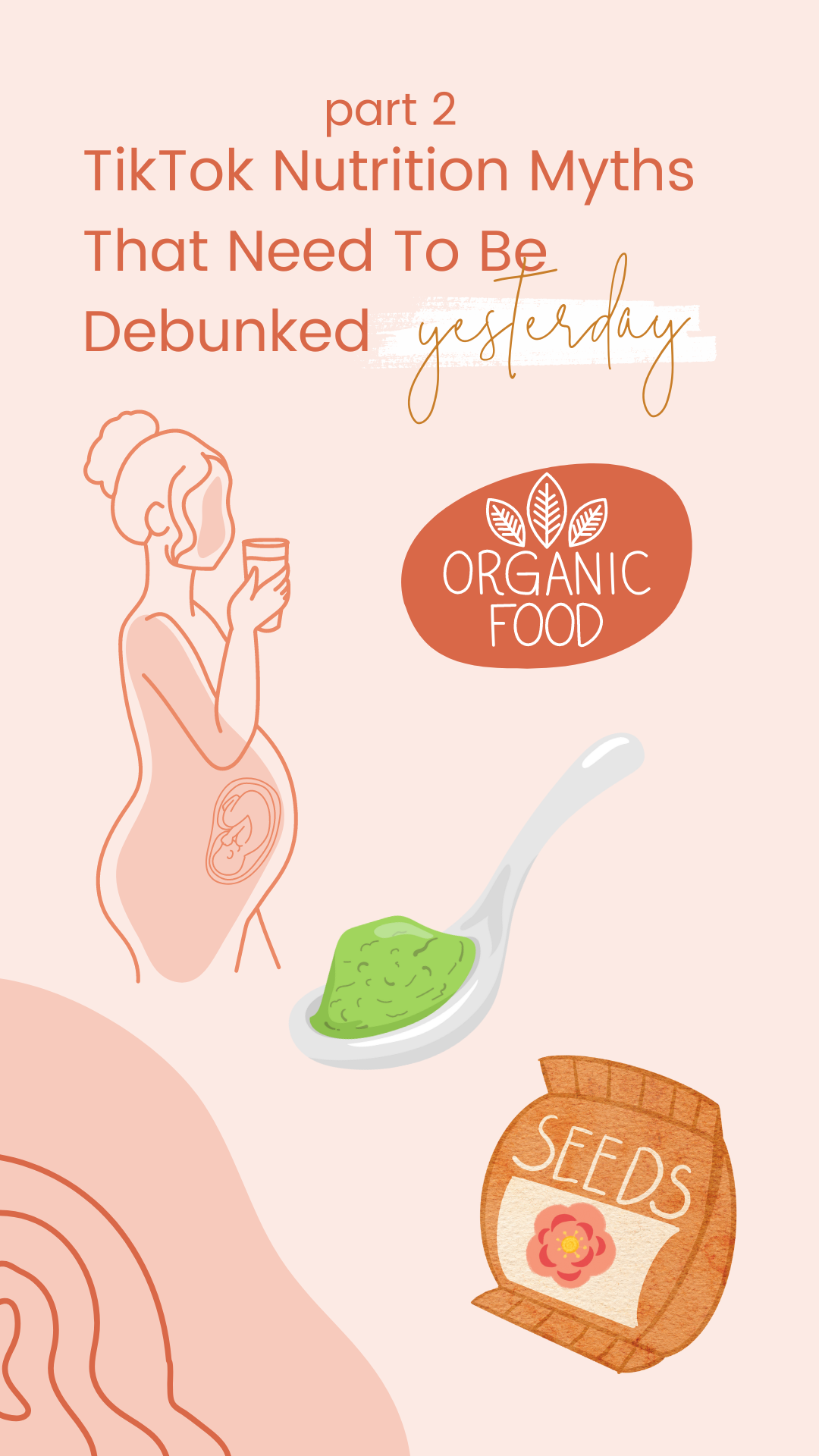TikTok Nutrition Myths That Need to Be Debunked Yesterday - Part 2
By Isabel Ebel - Feed Your Zest Intern
Hey y’all, Isabel here and I’m back for more TikTok nutrition myth debunking! You can find part 1 here. To recap, we love TikTok and think it’s great, however, a good amount of nutrition information on there comes from accounts that don’t share evidence-based information (unlike McKenzie @fertility.prenatal.rd, who always shares evidence-based information). Which makes it that much more difficult to decipher what is true and what isn’t! For more information on how to spot nutrition bs, check out this post on Instagram.
Once again, as a soon-to-be dietitian and Feed Your Zest intern, my time is consumed by all things dietetics, so I’m back to debunk some more nutrition myths that are popular on TikTok. Here we go again!!
Myth #4: Bloom Greens
If I had a penny for every time I’ve seen Bloom Greens on my FYP on TikTok, I’d have at least $600.00. Which equates to about 60,000 times. Don’t get me wrong; at first, I was skeptical… who wouldn’t want to drink a fruity beveragino and *snap* not be bloated, not have any digestion issues, and boost their immunity? I mean, duh. However, is that actually what’s happening? No.
Bloom’s website makes claims specifically for their Greens in regards to gut health support, immunity, and energy. What people don’t see is the very, very, small asterisk after these claims.
“* These statements have not been evaluated by the Food and Drug Administration. This product is not intended to diagnose, treat, cure or prevent any disease.”
While this statement is found on almost any dietary supplement, we also need to look for third-party testing, because the FDA tragically does not regulate the supplement market. According to this report from Forbes, Bloom Greens has not been third-party tested. When supplements are not third-party tested, it means that their product has not been tested for safety or validity. A stamp from a third-party testing lab ensures accuracy of the ingredient list and guarantees that there are no harmful or hidden ingredients in the product. Now, I’m not saying that Bloom is lying about any of the ingredients or amounts, but this is why finding supplements that are third-party tested is important.
In all honesty, I used to think, “while there’s no way Bloom does all this… if someone doesn’t like eating fruits and vegetables, this could be an alternative to getting a serving of them.” I was wrong. Looking at their nutrition facts label, there isn’t enough of anything in it to be considered a serving of any fruit or vegetable. It says, “packed with fruits and vegetables,” however, a serving of Blooms Greens provides 15 calories, 3 grams of carbs, and 2 grams of fiber. It is a bit confusing because the ingredient list is broken into half a dozen “blends,” that include a mixture of different fruits, vegetables, roots, leaves, and extracts, but the amount of each ingredient in a serving is miniscule.
All in all, the best way to actually improve your gut health, immunity and energy like Bloom Greens claims that it does is to eat enough food overall, and add real fruit and vegetables to your diet. By doing so, you’re ensuring that you receive the nutrients contained in the produce such as, the carbohydrates, the fiber, the antioxidants and vitamins and minerals.
Myth #5: Eating for your menstrual cycle.
The idea behind eating for your menstrual cycle is that each phase of the menstrual cycle (menses, follicular, ovulation, and luteal) comes with fluctuating hormone levels, which is true. This trend is similar to the seed cycling myth, which is discussed here.
However, here’s where it gets woo-woo. Which phase a person is in dictates what foods they should be eating in order to optimize their energy, mood, and skin. This makes the diet restrictive and creates rules around eating, which can be more problematic than helpful. It’s also assuming that every person’s cycle is 28-days in length, which is flat out incorrect. Just to make it clear, here are the truths that are hidden in the B.S. of this:
Our diets do have an influence on our hormones and menstrual cycles, but it’s not necessary to alter or restrict our diets to specific foods based on where we are in our menstrual cycles
Specific foods can affect our energy levels and mood. For example, a donut may give me a spurt of energy for an hour, but my mood will stay high all day long 😊
There is no evidence to say that specific foods consumed at specific times of a person's cycle will optimize their energy, mood, or skin
So, while you may see influencers on TikTok recommend consuming the following foods depending on the phase of your cycle, below I’ll explain what’s occurring in that phase and what is actually best to focus on, nutritionally.
Phase of the cycle: Menses
What TikTok influencers recommend during that phase: Iron rich foods
The truth: This is when people usually experience bleeding, and you may experience cravings for more iron-rich foods. There’s nothing wrong with listening to those cravings! Iron-rich foods can help replenish your body’s iron stores especially if you experience very heavy periods, but it’s best to consume them all month long if you are anemic to help maximize your consumption of this mineral.
Phase of the cycle: Follicular
What TikTok influencers recommend during that phase: Complex carbs
The truth: This is when the body is preparing to release an egg, so the body is doing a little more work and utilizing more nutrients - you may feel hungrier than usual, so honor that by listening to your body and fueling it with satisfying meals and snacks. Complex carbs are a great source of energy at any time of the month.
Phase of the cycle: Ovulation
What TikTok influencers recommend during that phase: Antioxidant-rich foods and vitamin D sources
The truth: Consuming antioxidants all month long will help improve egg quality and reduce inflammation overall. Vitamin D is important for implantation of a fertilized egg if you are trying to conceive. However, just like with iron, if you’re deficient in vitamin D, consuming vitamin-D rich foods all month long vs a few days during ovulation is a much more effective approach to getting your vitamin D levels up.
Phase of the cycle: Luteal
What TikTok influencers recommend during that phase: Healthy fats, extra protein, and calcium
The truth: This is when the body is preparing for menstruation, so it may utilize more nutrients because it’s doing more work than usual. You may feel hungrier - honor that hunger with satisfying meals and snacks that include all types of fats and protein, but including these at other times of the month is also important for blood sugar balance and getting all the nutrition you need. We’ve said it before about iron and vitamin D, and we’ll say it again about calcium - consuming calcium rich foods all month long is important for maintaining healthy bones and reducing your risk of preeclampsia should you become pregnant.
You may have noticed from the info above that really there are just two phases of the menstrual cycle - follicular and luteal, marked by the start of your period and ovulation. This makes the cycle-syncing recs even more muddy, when technically all the phases are bleeding together (no pun intended). On top of that, if you do not get a regular period due to a condition like PCOS or hypothalamic amenorrhea, then you might not always be going through these phases anyways!
Ultimately, if you’re including all foods in your diet, you wouldn’t need to focus on specific foods at specific times of your cycle! Eating only those foods at specific times of your menstrual cycle is not a well-rounded diet in general.
If you have any questions about your individual nutrition needs, especially concerning your fertility, talk with your dietitian.
If you are struggling with period pains and PMS, this blog dives deeper into some nutrition tips and tricks that can aid with that.
Myth #6: People should not consume caffeine when they are trying to conceive or if they are pregnant.
I won’t totally blame TikTok for this myth because it’s been around since dinosaurs roamed the Earth. However, it is incorrect. The recommended caffeine intake for people trying to conceive or who are pregnant is 200 mg/day, which is equivalent to about two cups of coffee or 3 shots of espresso.
The reason for the myth is that some believe caffeine to be associated with overall fetal safety and miscarriages. However, there is insufficient causal evidence showing that caffeine use is directly responsible for miscarriages, birth defects, or reductions in fetal growth.
The World Health Organization (WHO) and the American College of Obstetricians and Gynecologists (ACOG) both recommend pregnant people to limit their caffeine intake to less than 200 mg/day. These recommendations were based on studies that suggested potential associations with pregnancy losses and irregular fetal growth at higher levels of caffeine consumption. While there are studies that show it is safe to consume up to 200 mg/day, it’s up to the person if they would like to consume any at all. However, there is no need to feel shame or guilt for still enjoying some coffee or tea when TTC or when pregnant.
For more information on caffeine consumption when TTC and in pregnancy, check out these posts on Instagram and TikTok:
Benefits of matcha for fertility and pregnancy
Honey vanilla cinnamon cold brew recipe
Iced lavender vanilla matcha recipe
Coffee shop orders when pregnant
Whew x 2. Now that you’ve read my monologue for 2 whole parts, I hope you were able to walk away feeling empowered with the facts. So, just to recap part 2:
If you’re looking for an end-all, be-all fix for your gut health, boost your immunity and energy, you’re not gonna find it in a greens powder (no matter how much fruits, veggies, extracts, roots, etc. are in it). However, eating enough food overall and adding real fruits and vegetables to your diet is a good start
If you’re including all foods in your diet, there is no reason to focus on consuming specific ones throughout your cycle
If you’re TTC or pregnant, there’s no reason to feel guilty for enjoying a caffeinated cup of coffee/tea - up to 200 mg/day
Again, happy TikTok scrolling & don’t believe everything you see!
Is there a specific nutrition concept that you saw on TikTok that you’re skeptical about? Let us know in the comments and maybe we can help debunk it for you!
Psst!
Looking for more information about how to actually nourish yourself for fertility and pregnancy? Our group coaching program Fully Nourished Pregnancy walks you through how to utilize intuitive eating for fertility and pregnancy according to evidence-based nutrition science without a restrictive diet or mindset. Enroll in Fully Nourished Pregnancy with the option to add on The Insulin Resistance Mini Course today!
You can also learn more about what McKenzie offers for 1:1 clients here (she accepts BCBS insurance and is licensed to practice in multiple states).





